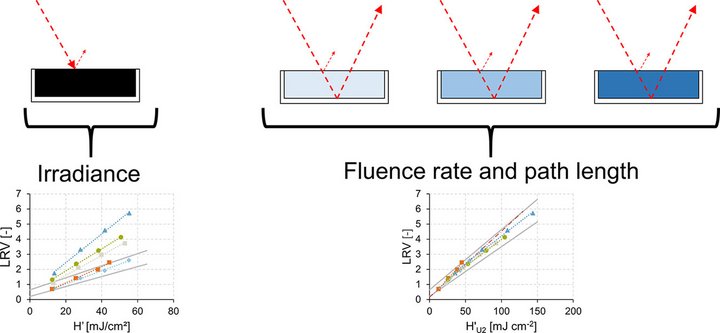The applicability of chemical actinometry to characterize the fluence in UV reactors with reflections, non-parallel light, and variable water transmittance is limited due to the unknown effective path length or hydraulic shortcuts within the reactor. In this study, the effects of reflection and transmittance on actinometry were examined and a new, optimized and easy method for determining fluence was developed. KI/KIO3 and uridine actinometry experiments were carried out under controlled conditions using a collimated beam apparatus and a completely mixed batch reactor with or without diffuse reflection and compared to biodosimetry results. Whereas optically opaque actinometers such as KI/KIO3 are not directly capable of predicting the fluence of reflecting reactors, the results of uridine actinometry are influenced by reflection and transmission. To precisely predict the fluence rate in UV reactors with uridine, knowledge about the effective optical path length of the light is needed. Here, an existing method to mathematically calculate the optical path length was adopted and optimized for uridine actinometry. Results for average fluence were validated by biodosimetry using MS2 phages under different degrees of reflection and transmission. It could be shown that by modifying the bottom of the reactor with diffusely reflecting polytetrafluoroethylene foil, the fluence rate was increased by a factor of approximately 2.6 and the path length by factor of 2.4. When only half of the bottom was covered with reflective foil, fluence rate increased by a factor of 1.8 and path length by 1.8. Although this new approach cannot replace biodosimetry, to predict the fluence distribution received by microorganisms, it can provide means to characterize more complex reactor designs, validate results of advanced reactor modeling, and quantify fluence for non-parallel irradiation and reflective light, especially for the application of high fluence (e.g., advanced oxidation processes), where biodosimetry may be too sensitive. Further, comparing the fluence obtained with actinometry to the results of biodosimetry might qualitatively indicate hydraulic short cuts or unideal fluence distributions for flow-through reactors.
Skip to content
Menu
- de
- en
Google Custom Search
Wir verwenden Google für unsere Suche. Mit Klick auf „Suche aktivieren“ aktivieren Sie das Suchfeld und akzeptieren die Nutzungsbedingungen.
